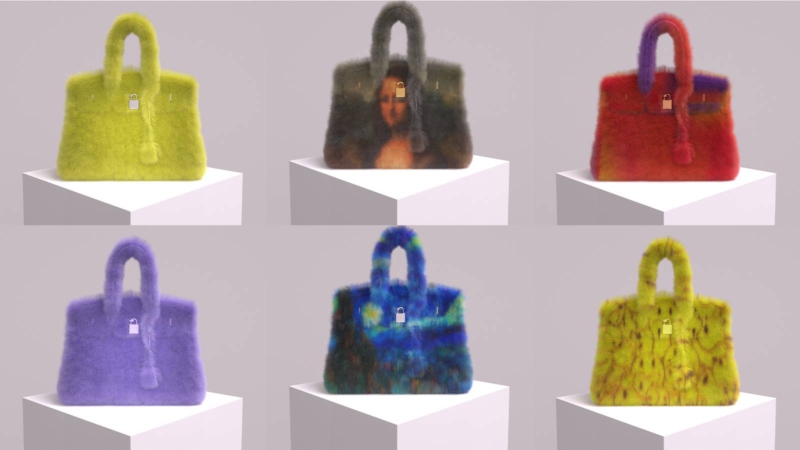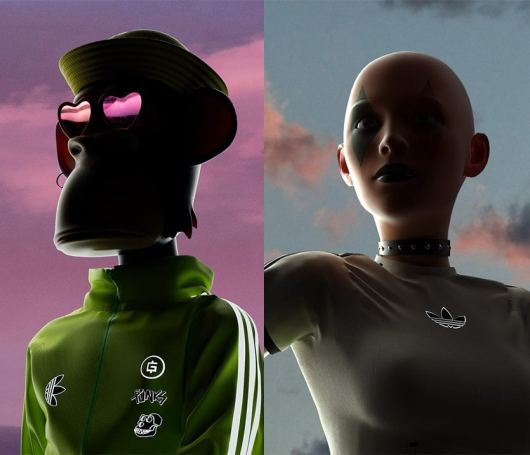The crypto-rich and the specter of a speculative-dystopian bubble
Fashion might be sociologically soluble in metaverses, but it is economically soluble as well. There exists a community of crypto-rich people who are ready to click “buy”: a community apart, split into several groups with their own particular semantics. First you have bitcoin’s “early adopters,” the mining pioneers who have profited from the explosion in the currency’s value. Then you have the “hodlers,” who refuse to sell their cryptocurrency whatever the pressure from the market’s irregular drops. And finally you have the “crypto-traders,” or “flippers,” who buy only to sell almost instantly, for quick profits. “But so far the number of crypto-wallet users remains below the number of internet users in 1997, which is a very limited number of people,” cautions Paul Mouginot. Which doesn’t mean the numbers won’t skyrocket. In 2021 volume in cryptocurrency exchange amounted to more than $14 trillion, by comparison with 1.8 trillion in 2020. “Why so much money invested in the virtual world when inequalities abound in the real one?” crypto-pessimists wonder. Others fear a speculative bubble. Collectors will hold a piece of modern art for two years on average, but the average hold for an NFT is only 30 days. “What we’re seeing is irrational exuberance, with trade constituting a big share of the market. NFTs of no artistic merit are bought and then sold to generate profits, until the day when no one wants to be left holding the ‘hot potato,’” says Luc Jodet.
Vincent Cocquebert : “ These cocoons are equal parts seductive and alienating. The question is, are they becoming a substitute for something that these days seems to be slipping away from us: the common safe space of our planet and all who inhabit it with us?”
Still seen as a futuristic-apocalyptic world in the collective imagination, the metaverse can at times stoke fears of dystopia. These virtual worlds provide an escape, an elsewhere to repair to, but they can also lead people to shut themselves in. They can serve as a isolating cocoon that dispenses with “what we hold in common” (le “commun”), to borrow an expression from Vincent Cocquebert, author of La Civilisation du cocon: pour en finir avec la tentation du repli sur soi (Arkhê, 2021). “These cocoons are equal parts seductive and alienating. The question is, are they becoming a substitute for something that these days seems to be slipping away from us: the common safe space of our planet and all who inhabit it with us?” So the scholar wonders. The least technophilic among us worry about the mass of data these platforms could collect, and about the creation of worlds that both lack intimacy and track users ever more intrusively. Certain experts, meanwhile, have recently expressed fears that metaverses will instill “false realities.” In November 2021, Louis Rosenberg, a pioneer in augmented-reality systems, wrote an article in Big Think warning of the potential dangers of these platforms and the risk that the technological layers set up between us and the data holders could be manipulated. In other words, third parties could introduce “layers of pay filters” enabling certain users to see specific tags over the heads of other individuals/avatars, the better to “label” them. “We’d use this layer to mark individuals with flashing boldface words, like alcoholic, immigrant, atheist or racist,” writes Rosenberg, adding: “Virtual superimpositions could easily be designed to exacerbate political division, ostracize certain groups, or incite hatred and distrust.” He’s not the only one to glimpse a “fake news world” of skewed, distorted reality lurking in the shadows.
 Photo: MetaBirkins.
Photo: MetaBirkins.
For now metaverses are developing outside any legal framework. In December 2021, a young woman who had taken part in a beta test before the official launch told of suffering (through her avatar) “a sexual assault” on the Horizon Worlds platform, the metaverse of Facebook (Meta). On a corporate scale, this January, the Hermès fashion house found itself thrust into a (meta-)dispute, filing a lawsuit in New York against an artist who had created NFTs, called MetaBirkins, that take inspiration from the brand’s famous fur handbags. “In web 3.0 there are neither states nor sanctions. It’s the Wild West,” says Benjamin Chiche, founder of Barney. “Brands are going to have to choose their partners very carefully to avoid abuses.” Not to mention digital pollution, which, though invisible, is all too real. “There’s law to be passed, a hierarchy to invent. Right now there is no meta-police or meta-security. We’re aware of the ethical and environmental stakes that these new worlds can raise,” says Mado Scott. “In fashion it’ll also be necessary to imagine new organizational structures, like virtual press bureaus and casting agencies for avatars,” says Lena Novello. “All of us at Barney are 25 to 35 years old. We feel we have a responsibility. We feel we belong to the generation in between, the one that will bridge the gap between technology and art, gaming and design, the metaverse and fashion. The metaverse is more than a technological subject. It’s also societal, and we have our role to play,” adds Benjamin Chiche.
Problems of inclusion and pedagogy
On paper the metaverse looks like a place to meet people and socialize. “We estimate that 30 to 50 percent of the users on Second Life have at some point found themselves with a social or physical handicap,” says Aurore Geraud, a researcher at the Atelier BNP Paribas. “There is testimony on the web on the social and psychological relief that virtual communities can offer. An autistic LGBTQIA+ person tells of finding in the World of Warcraft community the kind of refuge and support that she could not find in the real world.” For now, though, distrust reigns. Researcher Joy Buolamwini, of the MIT Media Lab, has already called out the sexist, racist and transphobic biases of the algorithms, devised for the most part by white men infusing the technology with their prejudices. How can minorities be included in the new world if they have no hand in its creation? It’s a topical question in light of the many debates over constant improvement of the UX (the user experience), debates that exclude the societal concerns of inclusivity.
As for cryptocurrencies, four years ago most of their holders worked in tech. Today much simpler systems enable ordinary people to set up a crypto-wallet and make transactions. “Our generation made the transition from the Nokia 3310 to the iPhone 13. We’re very malleable and very open to innovations. I’ve no doubt we’ll easily adopt the new customs,” says Benjamin Chiche. “But we’re still missing an element of education, and pedagogy. It’s another part of our profession to introduce the public to these new means of consumption and interaction,” adds Lena Novello.
Mark Zuckerberg is hoping a billion people will be in the metaverse 10 years from now. “The” metaverse? Will there be only one, or will several emerge? Will one metaverse prevail? Or will we be able to pass fluidly from one platform to another? Will we be able to wear our World of Warcraft armor at a concert on Decentraland or our Gucci sneakers at the movies on Roblox? “From the user’s perspective it’s both frustrating and time-consuming to create a separate account for every platform. That’s why interoperability and interconnection between metaverses will be the great challenge in years to come,” says Stefano Rosso. “We’re at the start of a revolutionary medium. It’s like the arrival of the Lumière brothers’ first films. We’re on the verge of a new world, concludes Mado Scott, where everything remains to be discovered.”

 Photo: Second Life.
Photo: Second Life. Photo: Fortnite x Balenciaga.
Photo: Fortnite x Balenciaga.
 Photo: MetaBirkins.
Photo: MetaBirkins.